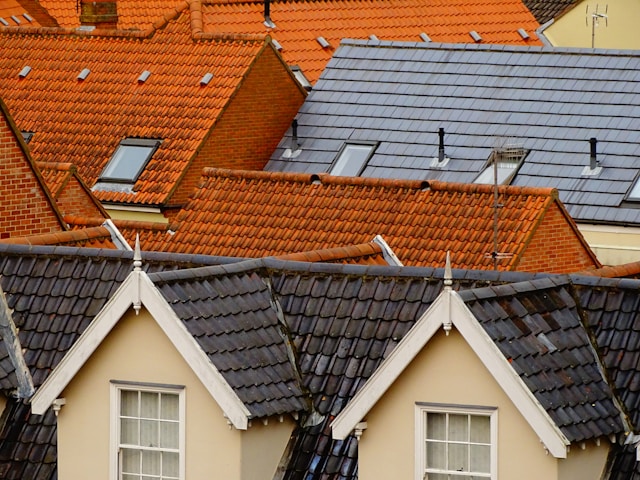Table of Contents:
- Introduction
- Roofs in Ancient Times
- Advancements in Roofing Techniques
- Medieval Roofs and Gothic Architecture
- Renaissance and Baroque Roofs
- Industrial Revolution and Modern Roofing Materials
- Contemporary Roofing Trends
- Conclusion
Key Takeaways:
- Roofs have evolved significantly, reflecting changes in technology, materials, and cultural practices.
- Ancient civilizations used locally available materials such as clay and thatch for roofing.
- Advancements in construction techniques, such as the invention of concrete and terracotta tiles, revolutionized roofing in ancient Rome.
- Medieval Gothic architecture featured elaborate timber-framed roofs covered with lead or slate tiles.
- The Industrial Revolution brought mass-produced steel, asphalt, and synthetic roofing materials.
- Contemporary roofing trends include green and solar roofs, reflecting a growing emphasis on sustainability and energy efficiency.
Introduction
Roofs have been essential in shielding human homes from the elements since ancient civilizations to current society. As essential architectural elements, roofs have evolved significantly, reflecting changes in technology, materials, and cultural practices. In investigating roofs through the years, we will explore the fantastic progression of roofing techniques and styles, from simple shelters to sophisticated buildings that define today’s skylines. Throughout history, roofs have provided shelter and served as symbols of cultural identity and architectural achievement. Roofs continue to evolve today, incorporating innovations such as structural monitoring building to ensure safety and longevity.
Roofs in Ancient Times
Ancient civilizations’ roofs, such as those of Mesopotamia, Egypt, and Greece, were usually built with locally accessible materials like clay, thatch, or stone. These early roofs were frequently flat or slightly sloping and served primarily to protect against the sun and rain. Thatched roofs, formed of bundles of reeds or straw, were common in agricultural civilizations and provided excellent insulation and ventilation.
Advancements in Roofing Techniques
Over time, construction techniques and materials advancements led to the development of more sophisticated roofing systems. In ancient Rome, for example, engineers pioneered using concrete and terracotta tiles to create durable and waterproof roofs for public buildings and villas. The invention of the curved barrel vault and dome allowed for the construction of grand architectural wonders such as the Pantheon, which still stands as a testament to Roman engineering prowess.
Medieval Roofs and Gothic Architecture
Gothic architecture emerged in Europe during the medieval period, characterized by its soaring vaults, pointed arches, and intricate tracery. Gothic cathedrals and castles featured elaborate timber-framed roofs covered with lead or slate tiles, providing structural support and protection from the elements. The steeply pitched roofs of Gothic buildings allowed for the efficient drainage of rainwater and snow, preventing water damage and structural deterioration.
Renaissance and Baroque Roofs
In the Renaissance and Baroque periods, architectural styles evolved to incorporate classical elements inspired by ancient Greek and Roman design principles. Roofs became more ornate and decorative, with elaborate gables, dormers, and finials adorning the facades of palaces and mansions. Timber framing and timber shingles remained prevalent in many regions, while wealthier patrons commissioned roofs constructed from copper, lead, or even gold leaf.
Industrial Revolution and Modern Roofing Materials
The Industrial Revolution resulted in substantial breakthroughs in construction materials and processes, transforming the roofing sector. Fast and durable roof construction was made possible by developing mass-produced steel, asphalt, and synthetic roofing materials, including rubber membranes and shingles. The introduction of steam-powered machinery and, later, electric-powered tools facilitated faster and more effective roof installation, fueling the growth of modern roofing systems.
Contemporary Roofing Trends
In the present day, roofing trends continue to evolve in response to changing environmental concerns, technological innovations, and architectural preferences. Green roofs, which feature living vegetation and vegetation layers, have gained popularity as sustainable solutions for urban heat island mitigation and storm water management. Solar roofs, equipped with photovoltaic panels, harness renewable energy from the sun to power homes and reduce reliance on traditional energy sources.
Conclusion
In conclusion, roofs have been central to human habitation throughout history, evolving from simple shelters to complex architectural marvels. From ancient thatched huts to modern skyscrapers, roofs have adapted to meet societies’ changing needs and aspirations worldwide. As we continue to innovate and explore new possibilities in construction and design, one thing remains constant: the roof will always symbolize shelter, security, and the enduring ingenuity of human civilization, supplemented by innovations like structural monitoring building to ensure their continued integrity.

